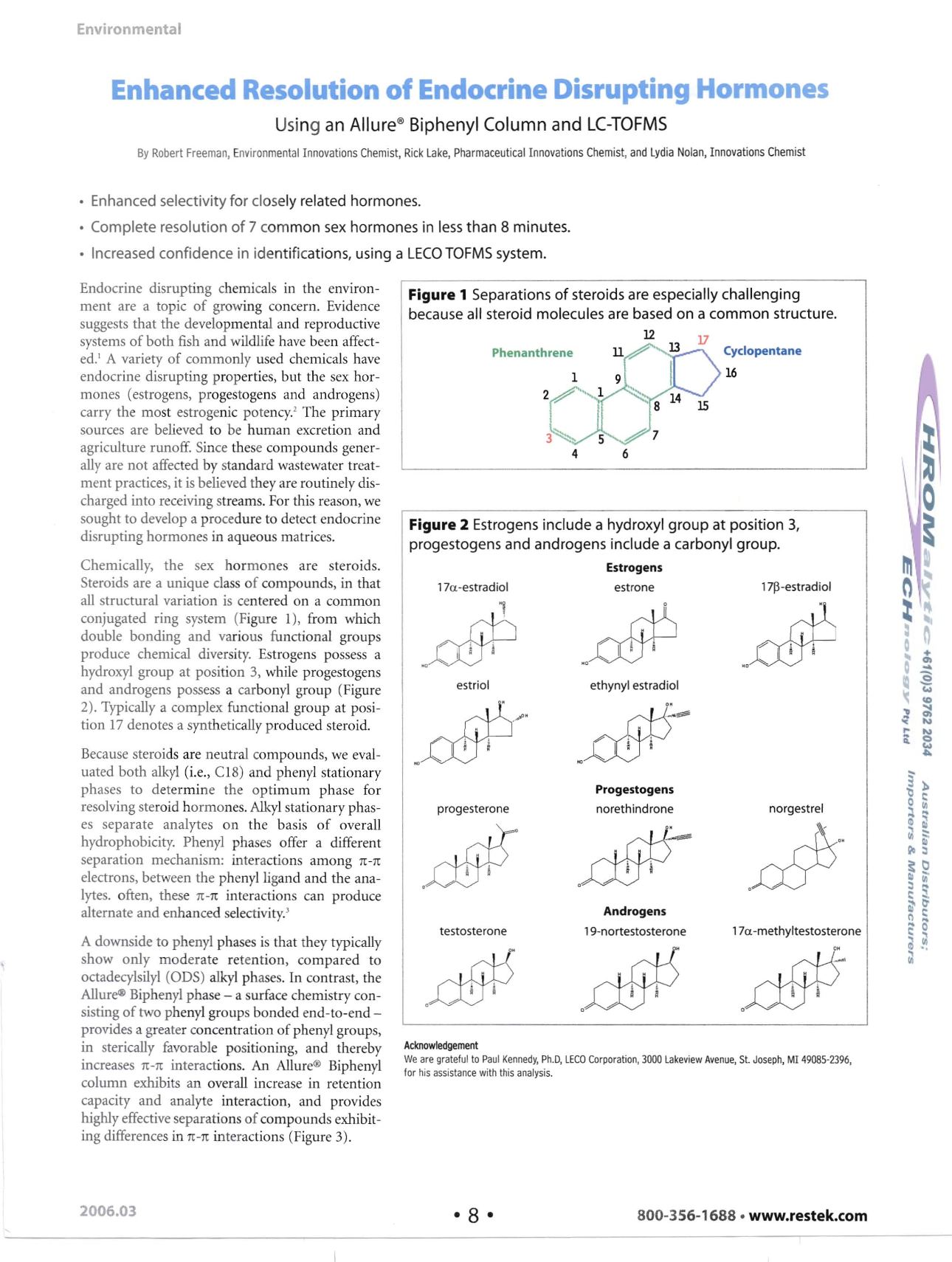

Environmental
Enhanced Resolution of Endocrine Disrupting Hormones
Using an Allure" Biphenyl Column and LC-TOFMS
ByRobert Freeman, Environmental Innovations Chemist, Rick Lake, Pharmaceutical Innovations Chemist, and Lydia Nolan, Innovations Chemist
• Enhanced selectivi ty for closely related hormones.
• Complete resoluti on of 7 common sex hormones in less than 8 minutes.
• Increased confidence in identificat ions, using a LECO TOFMS system.
Endocrine disrupting chemicals in the environ
ment are a topic of growing concern. Evidence
suggests that the developmental and reproductive
systems of both fish and wildlife have been affect
ed.' A variety of commonly used chemicals have
endocrine disrup ting proper ties, but the sex hor
mones (estrogens, progestogens and androgens)
carry the most estrogenic potency.' The pr imary
sources are believed to be human excretion and
agriculture runoff. Since these compo unds gener
ally are not affected by standard wastewater treat
ment practices, it is believed they are routinel y dis
charged into receiving streams. For this reason, we
sought to develop a procedure to detect endocrine
disrupting hormones in aqueous matrices.
Chemically, the sex hormo nes are steroids.
Steroids are a unique class of compounds, in that
all structural variation is centered on a common
conjugated ring system (Figure 1), from which
double bonding and various functional group s
produce chemical diversity. Estrogens possess a
hydroxyl group at position 3, while progestogens
and androge ns possess a carbonyl group (Figure
2). Typically a comp lex functional group at posi
tion 17 denotes a synthetically produced steroid.
Because stero ids are neutral compounds, we eval
uated both alkyl (i.e., C18) and phenyl statio nary
phases to determine the opt imum phase for
resolving steroid hormones. Alkyl stationa ry phas
es separate analytes on th e basis of overall
hydrophobicity. Phenyl phases offer a different
separation mechanism: inter actions amo ng
IT-IT
electrons, between the phenyl ligand and the ana
Iytes. often, these
IT-IT
interactions can prod uce
alternate and enhanced selectivity.'
A downside to phenyl phases is that they typically
show only mod erate retention , compared to
octadecylsilyl (ODS) alkyl phases. In contrast, the
Allure@ Biphenyl phase - a surface chemistry con
sisting of two phenyl group s bond ed end-to-end
provides a greater concentration of phenyl groups,
in sterically favorable positioning, and thereby
increases
IT-IT
interactions. An Allure® Biphenyl
column exhibits an overall increase in retention
capacity and analyte interaction, and provides
highly effective separations of compounds exhibit
ing differences in
IT-IT
interactions (Figure 3).
2006.03
Figure 1
Separations of steroids are especially challenging
because all steroid molecules are based on a common structure.
Cyclopentane
16
12
Phenanthrene
11
~
Figure
2 Estrogens include a hydroxyl group at position 3,
progestogens and androgens include a carbonyl group.
Estrogens
17a- estradiol
estrone
17p-estradiol
en
1
!
! -
I
""
I ' ,
o ,
""~
_0
""~
"'
""estriol
ethynylestrad iol
I
I-
i
"
~.
0
~~
I
I
i
""~
""-
~
Progestogens
progeste rone
noreth indrone
norgestrel
i
0#"
;
i
0
o
"'"
Androgens
testosterone
19-nortestoste rone
17a -methyltestosterone
"
i
:"
a a
, ,
• •
£t8+5
~
~
o
"'"
o
"'"
Acknowledgement
Wearegrateful to Paul Kennedy, Ph.D, LECDCorporation, 3000 Lakeview Avenue, SI. Joseph, MI 49085-2396,
for his assistance with this analysis.
800-356-1688 •
www.restek.com• 8 •
Website :
www.chromtech.net.auE-mail :
info@chromatech.net.auTelNo : 03 9762 2034 . . . in AUSTRALIA











